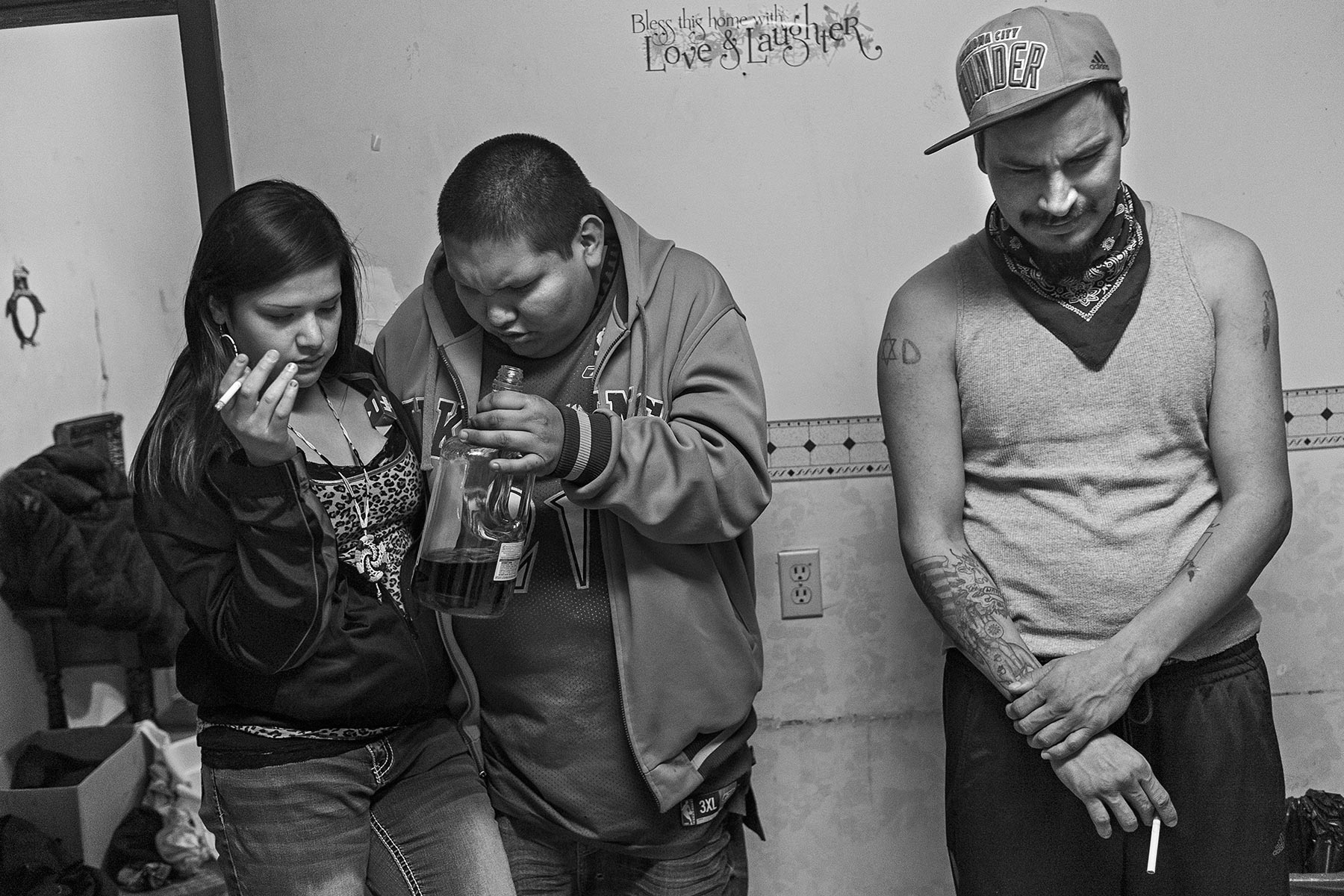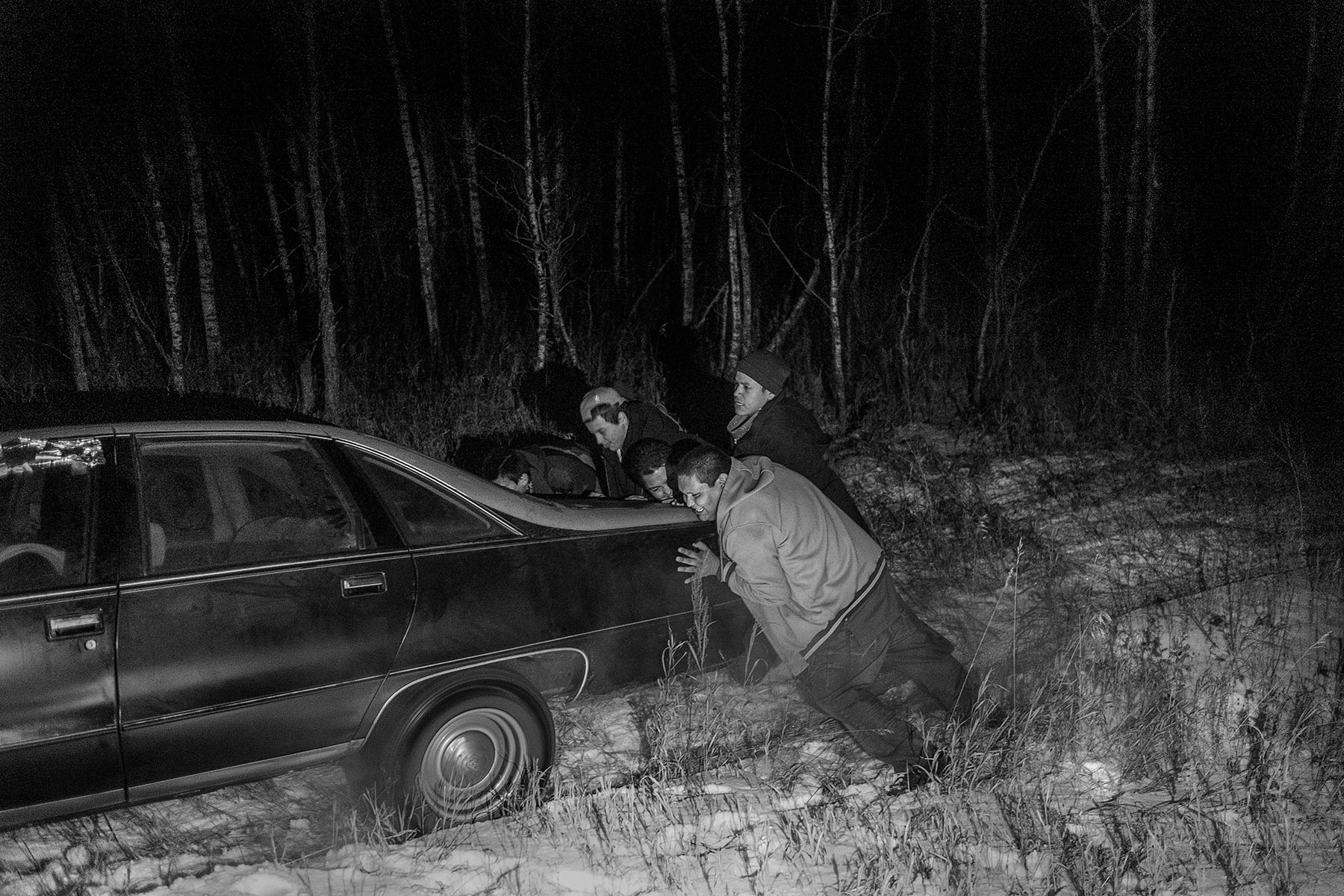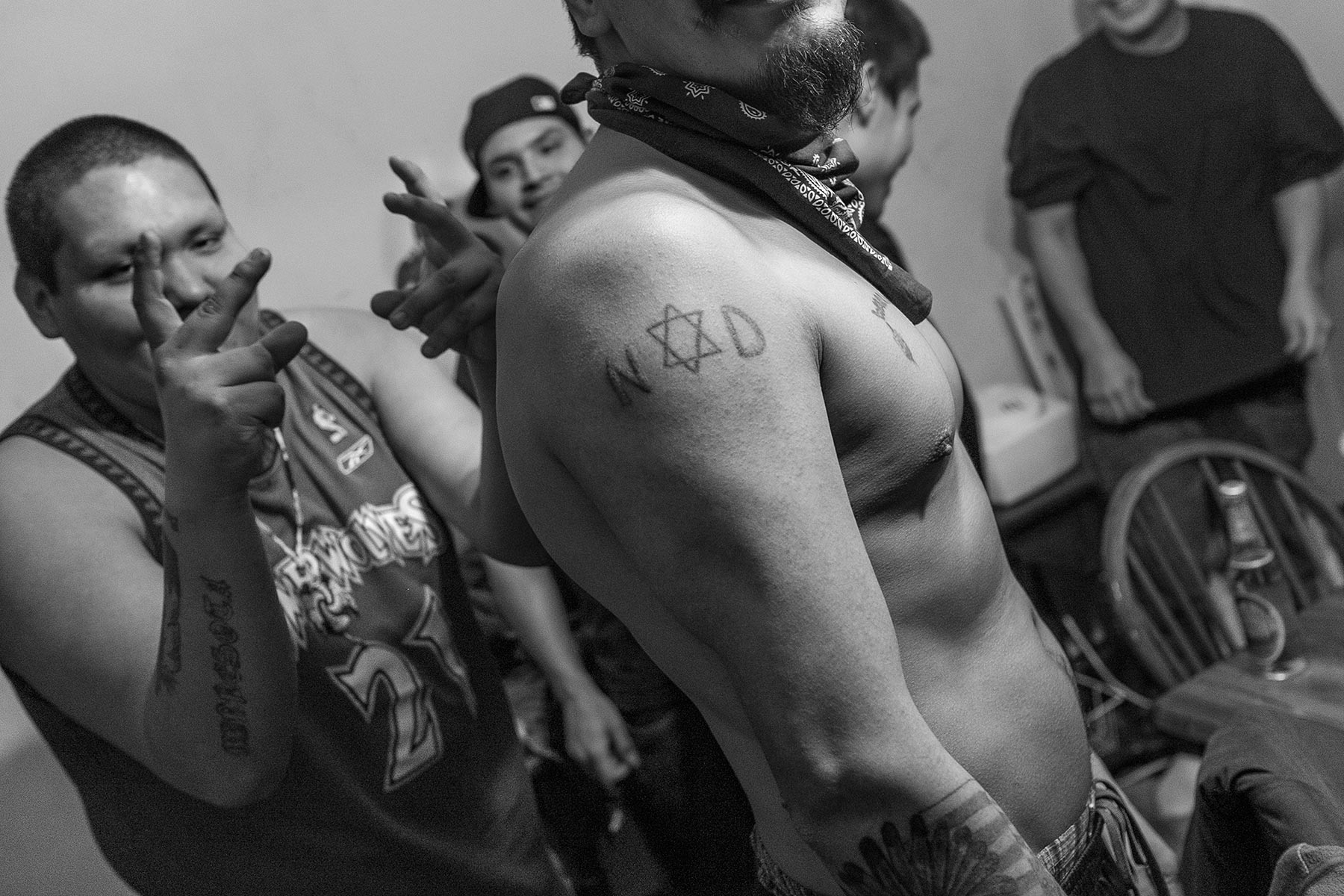
Boys in the Woods
A Saturday night in White Earth with the Native Disciples
About this project
This is the fifth story in a five-part series on Native American gangs.
By Tristan Ahtone for Al Jazeera America
Photos by Tomo for Al Jazeera America
Edited by Mark Rykoff, Katherine Lanpher
Senister, above and to the right, is a leader of the Native Disciples who had come to White Earth reservation to check with Dell, center, who is in charge of the Disciples there. Rainey, a friend, stands left.
Published on Friday, January 23, 2015
PONSFORD, Minn. — The boys passed a one-gallon bottle of spiced rum from person to person, waiting for Saturday night on the White Earth Reservation to begin. Cigarette and marijuana smoke curled slowly around the low-hanging light fixtures as caps were twisted off beer bottles and tossed onto counters or into an overflowing trash can.
Senister — who agreed to be interviewed only if he could use a pseudonym — lit a menthol cigarette, took a pull from the rum, and cleared his throat.
“We got members scattered everywhere, but there’s going to be a point when we need everyone in the field,” said Senister to the boys in the room.
Born 33 years ago in Oklahoma, the Ponca tribal member is a leader of the Minneapolis street gang known as the Native Disciples. He had traveled to the reservation to meet new members of the White Earth chapter, encourage morale and conduct something comparable to a military inspection.
“We’re trying to start a chapter in Oklahoma; hopefully we can get that started,” continued Senister. “We’re just trying to get bigger. I want you brothers to understand that.”
Compared to Senister, the Native Disciples of White Earth were children. The twins were the youngest at 16, while Dell, the regional capo for the gang, was the oldest at 19.
“I haven’t met most of you brothers, and there’s other brothers and sisters I haven’t met, but I’m going to make my rounds,” said Senister. “Salute!”
“Salute!” answered the room in unison as beer cans and bottles clinked together in approval.
Native people have endured cultural alienation, the loss of their language and their land, the destruction of family and social structures. They’ve weathered the resulting social dysfunction. For some youth, gangs offer a shelter from those realities.
The largest, most best-known gang in Indian country, Native Mob, has gone quiet after a massive shutdown of the organization in 2013, and while both old and new Native gangs are hoping to take its place, the Native Disciples are likely the only group with the ability to do so.
Instead of feathers and leathers, today’s Indian renegades wear baseball caps and baggy pants. But unlike previous outlaws, they’re as big a threat to their own people as they are to the realities they push back against.
Dell dusted snow off Travis Buckanaga’s tombstone while Gordy straightened a plastic wreath and replanted a wooden cross with a blue bandanna tied to it.
“That’s how we got to know Senister,” said Dell as he stood back to admire his cemetery maintenance work. “Because this guy right here died.”
In January of 2013, Native Disciple Travis Buckanaga was shot and killed at a house party near the White Earth Reservation, and Senister, along with other Native Disciples, traveled to the reservation to attend the funeral. By the end of their visit on White Earth, they had recruited half a dozen new members to the Native Disciples and left Dell in charge.
“In the city there’s a lot of action; out here there’s nothing,” said Gordy. “It’s way different from Minneapolis.”
Leading up to the early 1990s, gangs in Minneapolis’ Native American neighborhoods primarily existed for protection. Gangs from Chicago, Detroit and other major cities had begun moving into the area, and Native kids often banded together to resist the growing number of threats. There were groups like the Clubsters, the Naturals and the Death Warriors — small, all-Native gangs going up against larger, primarily African-American, outfits.
Minnesota’s two most prominent Native American gangs — Native Mob and the Native Disciples — began with the killing of Randy Pacheco.
Randy Pacheco was a Native member of the Vice Lords, a Chicago-based gang that had moved to the Twin Cities, and was shot in 1994 after an altercation with the Bercier brothers.
The Bercier brothers, Joe and Terry, were members of the Shinob-Mob, a small Native gang formed in East Phillips. Terry Bercier was convicted for the murder, while Joe Bercier went free.
With Joe out on the street, Pacheco’s fellow Vice Lords wanted revenge for his death. As per Vice Lord rules, they went to leadership for permission, but when the gang’s all-African-American leaders told them no, Pacheco’s Native compatriots did it anyway and were excommunicated. They formed their own gang: Native Mob.
Of course, the killing of Joe Bercier meant someone would have to pay, and the Gangster Disciples — another Chicago-based gang that had moved to Minneapolis — had ties to the Bercier family.
Tit for tat escalated, and Native members of the Gangster Disciples soon found themselves at war with Native Mob and the Vice Lords. Again, following Gangster Disciple rules, Native members went to their leadership to ask for help as violence intensified. The gang’s African-American bosses turned them down, and the East Phillips Gangster Disciples had to fend for themselves. They eventually split to form the Native Disciples.
Nearly 20 years later, in 2013, local, state and federal officials launched a takedown of Native Mob resulting in dozens of arrests and convictions under the Racketeer Influenced Corrupt Organizations Act (RICO). The gang’s membership was estimated at more than 200 members across cities and reservations in Minnesota, Wisconsin and North and South Dakota, and Native Mob’s crimes included drug trafficking, weapons sales, assault, witness intimidation, murder, human trafficking, sexual assault and racketeering.
Currently, the Native Disciples are working to catch up.
At a snow-covered, Y-shaped intersection on the White Earth Reservation, the twins’ beastly Chevy Caprice turned left, jerked right, then banked left again before missing its turn and gliding up a hill, narrowly avoiding a head-on collision with a thicket of trees. The car bounced and jerked, then jackknifed into the air, its headlights illuminating the ice-covered treetops for a moment before returning to earth with a crash, blowing out its two front tires and careening into a ditch.
The engine died and the entire car steamed in the snow. The car’s occupants spilled out, wide-eyed and confused and screaming with laughter.
Senister looked on in disbelief: Almost half of the White Earth chapter of the Native Disciples was now stuck on the side of a snow-covered reservation back road in the middle of the woods. Some of the boys laughed and giggled while others opened fresh beers or walked to the side of the road to pee.
“Dell, where the hell are we right now?” demanded Senister.
“I don’t know, bro,” replied Dell as he took a swig of beer.
“We’re in your neck of the woods, dude, and you got us messed up out here!” yelled Senister. “This is not how capos operate!”
“Yeah,” replied Dell as he finished his beer and tossed it toward the woods.
“You take orders, and if you don’t, we have something for you when you don’t want to listen to us,” said Senister. “You might not know, but we’re a part of something. What do you call that in college?”
Everyone thought about it for a moment.
“A sorority,” someone answered.
“It’s like a sorority, you know what I mean? You gotta keep your people in line,” yelled Senister. “If we have to come up here and show you brothers what to do, we can do that.”
About 45 minutes later a beat-up old minivan skidded up at the scene and opened its doors. The boys scrambled in, then took off toward the liquor store to buy another gallon of spiced rum and meet up with the rest of the crew.
Detailed information about gang activity in Indian country is hard to come by. In 2000, the National Youth Gang Center found that 80 percent of Native gang members were male, and that around three-quarters of them were under the age of 18, but its findings were inconclusive as to how many gangs there are in Indian Country. No studies have been done since.
“There’s no one-size-fits-all for Indian country,” said Walter Lamar, a former deputy director of the Bureau of Indian Affairs’ Office of Law Enforcement who now runs his own law enforcement consulting firm. “Gangs are sucking the lifeblood out of some of our communities; then in others, you basically have a group of young people that are engaged in vandalism.”
Native Disciples gang chapters can be thought of a bit like corporate franchises. On the White Earth Reservation, for example, members get to represent the organization and can ask for assistance if war breaks out, but mostly they sell drugs and send a portion of the profits back to the head office in Minneapolis. On White Earth, Dell serves as the gang’s regional capo, but he answers to capos in the city — people like Senister.
In Minneapolis, the Native Disciples rely on three capos to make decisions instead of one boss, so that if disagreements arise there will always be a majority vote on the course of action.
“Most gangs, especially in Indian country, are loose-knit groups of 20, 30, 40 individuals, and one or two people will emerge as the leaders,” said Mike Martin, president of the Minnesota chapter of the Midwest Gangs Investigators Association. “That’s different than having a hierarchical structure like Native Mob has, like the Native Disciples have.”
In 2011, the FBI concluded that most Native American gangs were disorganized, lacked structure, had scarce ties to national-level gangs and could not control large geographic areas or populations. However, gangs like the Native Disciples and Native Mob demonstrate that there are growing exceptions to the rule.
“These kids are not Cosa Nostra; these are not Medellin or Cali cartels, but they are seriously influential and dangerous elements in the community,” said Bryan Kastellic, task force commander of the Wisconsin-based Native American Drug and Gang Initiative. “These are not groups that we ever underestimate.”
Senister pulled one of the twins into the living room and leaned in close.
“Take care of that,” he said quietly. “You ain’t got to go overboard, just take care of it.”
“I’ll take care of that,” replied the boy.
“No,” said Senister. “I want to see it. You boys can say you’re going to do it, but whatever.”
The boy nodded dutifully, then looked nervously around the room and out the window to where a small cadre of the boys had gathered in the yard.
“We gotta hold each other accountable, because if we don’t, nobody else will,” said Senister to the boy. “Nobody cares about us Natives. How we eat. How we live. They don’t care. We gotta look out for each other. Now let’s take care of that. You ready?”
“Yeah,” replied the boy.
Senister bent his knees just enough so his eyes were level with the boy’s and looked into his face.
“You ready?”
The boy nodded.
A few minutes later the Native Disciples had made a circle in the yard around one of the boys, who lay on his back in the snow.
“Why are you doing this?” screamed the boy. “I didn’t do nothin’!”
The Native Disciples moved in closer, tightening the circle. The boy wailed.
“Hit him,” someone yelled.
With arrests and indictments having resulted in the temporary absence of Native Mob, a power vacuum exists in Minnesota’s Indian gang world. And while both new and old gangs are eager to fill it, the Native Disciples may be the only group with the organization and manpower to do so.
What the state’s Native gang landscape will look like by the end of the year, or 10 years from now, is hard to predict. Native Mob could return stronger than it was before, it could split into factions, or it could disappear. The Native Disciples might be prosecuted on RICO charges, or expand into chapters as far south as Oklahoma, or be at war again with larger outfits moving into their territory, as they were in the 1990s. Right now, they’re just settling into Indian country, and waiting.
“You can do anything in life, but you have to work for it. Take it. There’s no free lunch,” said Senister. “Anything we’re going to do, we’re going to have to fight for it, or we’re going to have to kill for it.”





